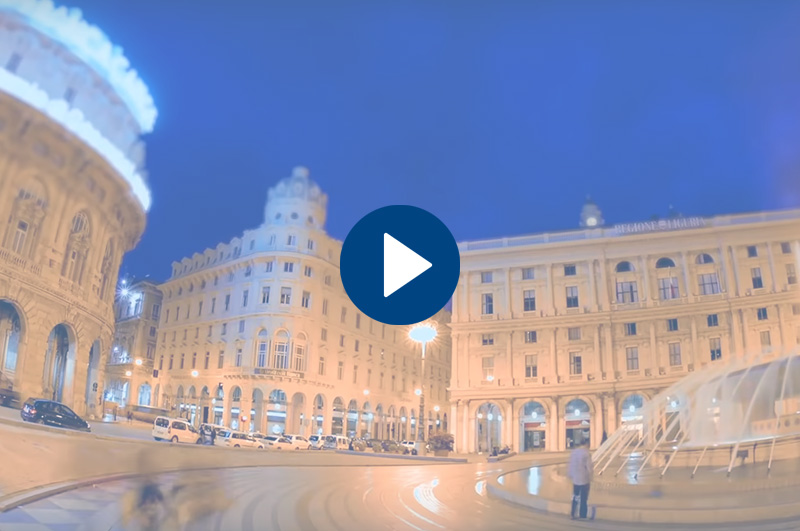EASTERN SICILY TOUR
Around Eastern Sicily, the cradle of Italian civilization: Val di Noto and its marvelous Baroque, glamours Taormina, Agrigento and its imposing Temples, Greek Siracusa and Roman Piazza Armerina.
At the discovering of the culture and spirit of this wonderful island!
WHAT'S INCLUDED:
Accommodations in Siracusa area with Continental Breakfast, to be chosen among the following:
- Villa
- Relais
- Hotel
Private Guided Visits / Tours / Activities to be chosen among the following (**):
- Full-day excursion of Val di Noto area with an Authorised Tourist Guide
- Sicilian Cooking Class in Val di Noto area
- Full-day excursion to Taormina - 3-hour private walking tour of Taormina city centre with an Authorised Tourist Guide
- Full-day excursion to Mt. Etna area – Visit of a local wine cellar with tastings and lunch
- Full-day excursion to Siracusa - 3-hour private walking tour of Siracusa city centre with an Authorised Tourist Guide
- Full-day excursion to Catania – 3-hour private walking tour of Catania city centre with an Authorised Tourist Guide
- Full-day excursion to Piazza Armerina - 1.5-hour private walking tour of Villa Romana del Casale with an Authorised Tourist Guide
- Full-day excursion to Agrigento - 3-hour private walking tour of the Valley of the Temples Archeological Area with an Authorised Tourist Guide
(**) All transfers and tours by private car (2 pax) / minivan (3 to 7 pax) / minibus (8 to 10 pax) / Rental car
Admission tickets to be chosen among the following:
- Greek Theater in Taormina
- Villa Romana del Casale in Piazza Armerina
- Valley of the Temples in Agrigento
Full emergency assistance 24 hours/day by our Back Office
List of recommended restaurants along the itinerary
All taxes
Options:
- Other options upon request
VAL DI NOTO
In southeastern Sicily, Val di Noto (the Noto Valley) – with its eight gorgeous late-Baroque cities – became one of the Italian UNESCO World Heritage Sites in 2002. The eight, Caltagirone, Militello Val di Catania, Catania, Modica, Noto, Palazzolo, Ragusa and Scicli, already existed during the Medieval Age. Still, they were rebuilt (in part or entirely) after the catastrophic earthquake of 1693. Following the stylistic model predominant during the era, the cities’ architecture, urban plan and decorations constitute the culmination of one of the last periods of Baroque’s flourishing in Europe.
Known in antiquity as Ibla, Ragusa features two somewhat different city centres, one reconstructed from the ground up, in the new style, after the events of 1693 and the other according to its original Medieval look. An itinerary through the Baroque in Ragusa winds among nine principal churches (e.g. San Giovanni Battista, San Giorgio, Santa Maria dei Miracoli) and seven palazzi (including the Cancelleria, Bertini, and Cosentini).
Palazzolo and Modica also have two urban centres. The first one in Palazzolo is a Medieval centre around which the old city was rebuilt after the earthquake. The new town subsequently developed around another town centre. The Churches of San Sebastiano, and Saints Peter and Paul are of particular importance. Of rare beauty, Modica and its old Castle centre are high on one of the hills in the Iblei Mountains, while the other, newly-constructed one lies down in the valley. Among the spectacular urban monuments, the Cathedral of San Giorgio and the Church of St. Peter (the “Duomo” of the lower city) certainly merit a visit.
The city of Noto is rehashed in an entirely new area, also divided into two levels. The more recent section, on an incline, provides a spectacular composition of streets and buildings in the Baroque, from noble palaces such as Palazzo Ducezio to religious complexes - the Cathedral of San Nicolò, for example.
Finally, the last pearl on the string of the Noto Valley's cities is represented by magnificent Scicli, where churches and patrician villas make for a visibly striking urban panorama. Specifically, Palazzo Beneventano (especially its glorious facade) is an architectonic and artistic masterpiece.
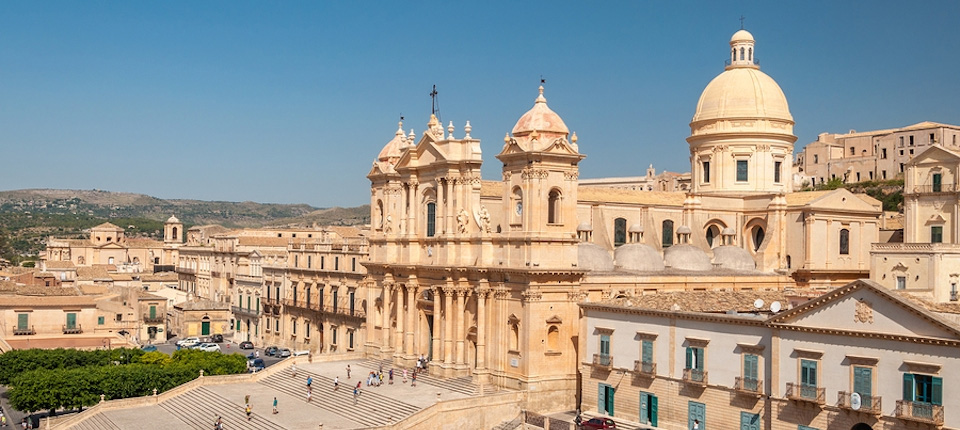
TAORMINA
Taormina, the “Pearl of the Mediterranean”, sits on a natural terrace above the sea. The Greek Theatre is one of the most suggestive spots, sited in a fantastic position and dipped into the blooming nature of this land. The view goes across the sea and reaches the Calabria coasts, the town of Siracusa and Etna's peak. Undoubtedly, today and at that time, the audience is fascinated by this beautiful view.
A walk in the Villa Comunale, offering typical Mediterranean maquis vegetation with a nice view sheer above the sea, is not to be missed. The coast offers charming sandy beaches lapped by crystal-clear water: the ones of Giardini Naxos and Mazzarò are the most frequented. In front of Capo Sant' Andrea, the coast of Isola Bella is today a protected natural oasis. After spending the day at the beach, you can shop in the workshops on the main street, where you can find everything – from pottery to jewels, from clothes to souvenirs. Or you can rest, drinking a lemon slush served with a hot brioche or a typical cassata siciliana.
The main food is, of course, fish: sardines, swordfish according to the best Sicilian tradition, but also eggplants, ricotta, olives and any good product that grows under the sun of this land.
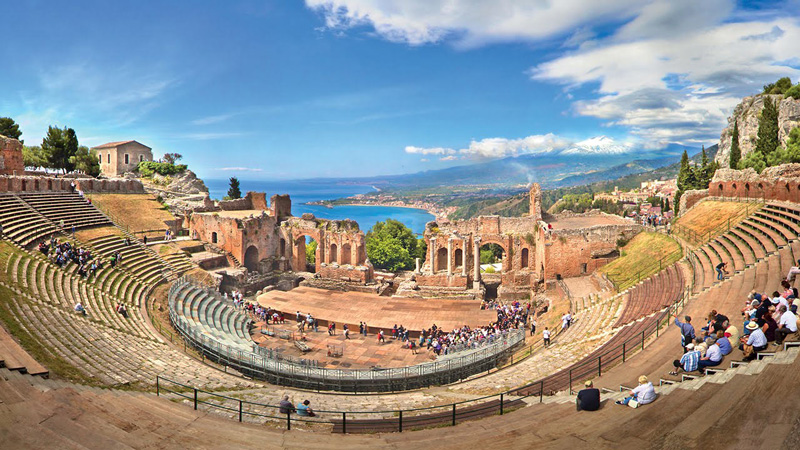
SIRACUSA
Cicero defined Syracuse as “the most beautiful city in Magna Graecia.” He was right, of course. Still today, the echoes of its ancient grandeur reverberate from the streets, churches and monuments, corroborating its religious and cultural importance: Syracuse is a destination no traveller should pass up and, with Sicily's Mediterranean climate, can be visited in any season of the year.
Made a UNESCO World Heritage Site in 2005, the city conserves ancient vestiges in every niche and corner, from Classical testimonies to Baroque splendours, all within a landscape of enchanting beauty. The UNESCO Site actually includes two different places: the cave necropolis of Pantalica and the historical centre of Syracuse. Both evidence the development and progression of ancient civilizations.
Thanks to its enviable geographic position, Syracuse was a crucial crossroads of commercial exchange since the Greeks settled it. Today it is a living artefact, connoting the customs and traditions of the many Mediterranean populations that passed through and dominated it, from the Byzantines, Bourbons, and Arabs to the Normans and Aragonese. Sùraka, as Syracuse is known in Sicilian dialect (meaning an abundance of water), was one of the principal settlements in Magna Grecia, a place of artistic brilliance and commercial power. It was also one of the most important centres of Christianity during the Middle Ages, and it later saw its Baroque golden age after the earthquake of 1693. However, the oldest urban nucleus resides on the little island of Ortygia, where we find the Temple of Apollo, the most ancient in Sicily. The remains from the Temple of Athena (5th Century B.C.) were later converted into the Cathedral, while the Temple of Zeus “rui culonne” (two columns) because what is left of the entire structure consists of just two columns.
In the 4th Century B.C., Syracuse expanded via the residential quarters of Tyche and (the monumental) Neapolis ( Ortygia, Acradina and Epipoli already existed). Traces left by the Roman conquest include the beloved Amphitheatre, while just as magnificent is the Castello di Maniace, a Byzantine citadel commissioned by Frederick II of Swabia.
The Cave Necropolis of Pantalica is not far from Syracuse, close to open quarries. Pantalica became a refuge on the plateau of the Iblei Mountains for the coastal inhabitants fleeing the Sicels and other Italic populations that landed here in the first half of the 8th Century B.C. (the period to which these scenographic necropolises date). The complex consists of approximately 5,000 tombs dug into the rock, and the Anaktoron (Prince’s Palace) positioned at the top of a hill, a reminder of the majestic Mycenaean palaces.
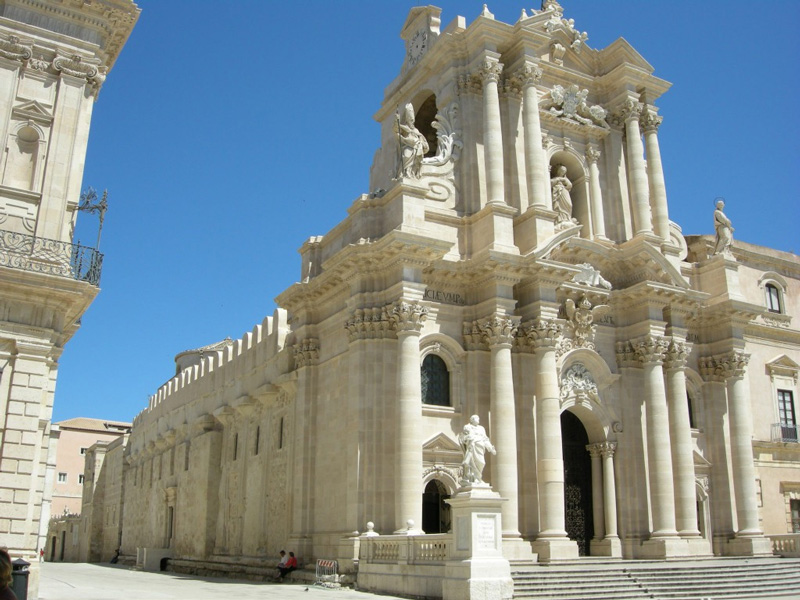
PIAZZA ARMERINA
In Piazza Armerina, you will visit one of the most remarkable examples of Roman art in the whole Mediterranean area: Villa Romana del Casale.
Originally the property of a powerful Roman family, this majestic Imperial villa is a magnificent rural abode, fascinating for its exquisite mosaics, considered the most beautiful and best-preserved of their kind. The fruits of meticulous labour, these precise yet moving images make for a significant adornment to what remains of this luxurious residence – made a UNESCO World Heritage Site in 1997.
Dated back to 320-350 A.D., the villa most likely belonged to a member of Rome’s senatorial class, probably a governor of the Eternal City itself (Praefectus Urbi). However, some scholars would maintain that the villa was built and eventually expanded upon the official commission of an Imperial functionary of a high order; they have identified this person as Maximian, a Tetrarch (one of four co-Emperors) of Diocletian.
Archaeologists undertook an important excavation project in the mid-18th Century, bringing to light 37,674 sq ft of mosaic flooring – figurative and geometric – along with wall mosaics, columns, statues, capitals and coins. The theme of the mosaics is the celebration of the homeowner. Moreover, much of the house exhibits a definite influence from North African art styles, leading diggers and academics to believe that some construction workers were from the African Continent. The viewer can detect varying styles and narrative cycles in the mosaics: one is dedicated to mythology and Homeric poems, while another refers to nature and scenes from the Roman aristocracy’s quotidian life.

AGRIGENTO
In the Valley of the Temples (a UNESCO World Heritage Site), the fascination of ancient history blends with the beauty of nature. The sea on one side, the old city-hill on the other, the majestic Doric-style temples rising in the centre of it all, and the tones of the tufo with which they are constructed create a picture-perfect setting.
The Temple of Concordia is the most well-preserved of the temples, having been transformed into a church. The Temple of Juno still boasts 25 of its original 34 columns to support its structure. Then, the Temple of the Dioscuri is considered the most symbolic, while the Temple of Hercules is the oldest. Together with the Temple of Zeus, these five giants dominate the Valley.
Leaving the Valley and heading towards the city, you will come across the remains of the Hellenistic-Roman Quarter, with its houses decorated in beautiful mosaics. The ancient shops, wells, cisterns and the sewer system lend a relatively clear idea of how the old city looked. Evidence abounds from the Greek era: be sure to see the fascinating objects at the Regional Archaeological Museum; they originate from the ancient area of Akragas.
Through the Porta di Ponte, you will enter the ancient quarter of Agrigento, still conveying the image of a Medieval village, with its narrow roads and steep, winding alleys all converging towards the main road. Stroll through the ancient city and wander to the Cathedral, where a grand stairway leads to the churchyard and bell tower, the construction of which has never been completed.
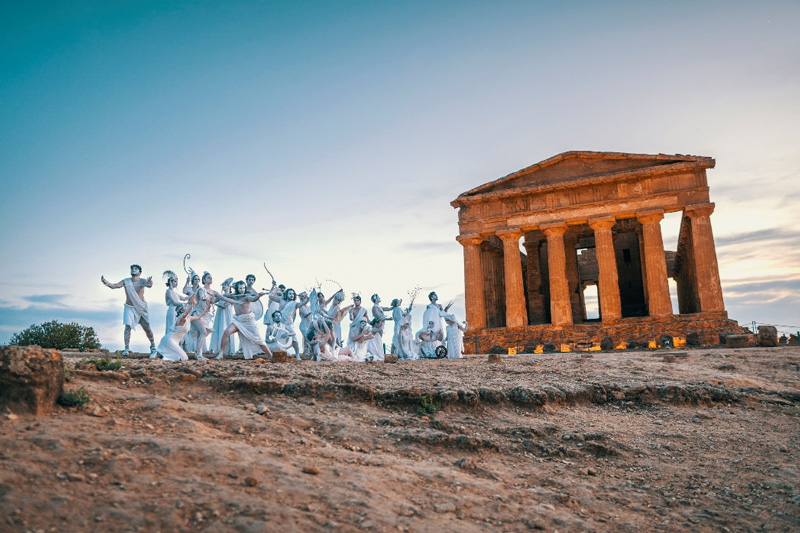
CATANIA
Located at the foot of Mount Etna, which often provides thrilling eruptions, Catania overlooks the Ionian Sea. It is a beautiful art city, an undisputed example of Sicilian Baroque, a UNESCO World Heritage Site, and other towns in the Val di Noto.
Catania was founded originally as a Sicilian settlement, then re-founded under the name of Kατάvη in 729 BC by Greek colonists from Chalcis. In the fifth century BC, it was occupied by the Syracusans, who named Etna, and the Romans later conquered it in 263 BC. With the fall of the Roman Empire, the city followed the fate of Sicily before being conquered by the Ostrogoths and then by Arabs, Normans, Swabians and Angevins.
Shocked by the terrible eruption of Mount Etna in 1669 and the disastrous earthquake of 1693, the city was almost entirely rebuilt in the early eighteenth century in the Baroque style of the time that characterizes the entire southeastern Sicily.
Catania is a city that fascinates, starting with the remarkable remains from the Roman period, such as the Odeon, located in the historical centre next to the Roman theatre. This building was built in the Greek era but was restored between the 1st and 2nd centuries. Other monumental structures also belong to this period, including the amphitheatre and some buildings made with hot lava stones. Do not miss a visit to the Ursino Castle, founded by Frederick II in the thirteenth century, and today a museum.
Catania, a notable example of Sicilian Baroque and post-earthquake reconstruction, preserves the urban plan designed by Vaccarini, with wide straight roads that link up around the main street. Via Etnea, on open squares and gardens. Among these scenic roads is the Piazza del Duomo, home to the characteristic Fontana dell'Elefante, the true centre of the historic city. Visiting Catania is a constant surprise: you can walk among the great eighteenth-century boulevards and relax in one of the rooms along the beautiful Via Etnea, the heart of Catania and the ideal place for shopping.
For those who love the sea, the coast of Catania, characterized by alternating sandy beaches and rocky volcanic shorelines, leaves visitors spoiled for choice. A variety of possible excursions can be found near Etna, such as pine forests, areas of black lava, and steaming craters. Catania is, therefore, a multifaceted city and is noted for the cultural life that revolves around the university, one of the oldest in Italy (1434).
Catanese cuisine is some of the best in Sicily. Make sure to try the traditional seafood dishes. "Pasta alla Norma" is a typical dish, as is pasta with squid ink and "mascolini." A must-try is the fine DOC wine of Etna and, at the end of the meal, a typical dessert like cannoli with ricotta cheese, Sant'Agata nougat and marzipan.

